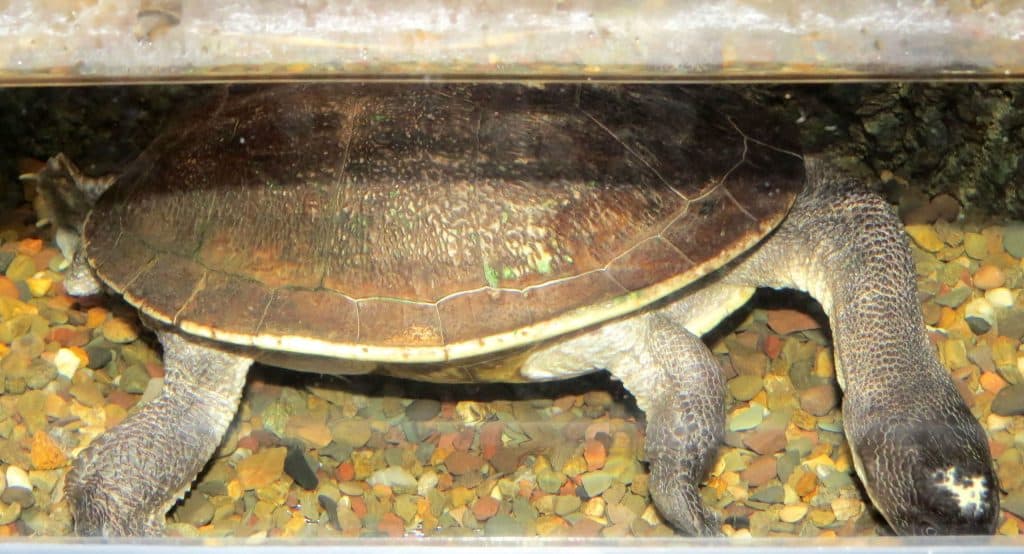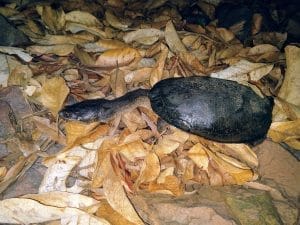Chelodina novaeguineae (New Guinea Snake-necked Turtle)
Home > Turtle Database > Chelodina novaeguineae (New Guinea Snake-necked Turtle)

Chelodina novaeguineae, commonly known as the New Guinea Snake-necked Turtle, is a unique species recognized for its long neck and distinct appearance. It is primarily found in the freshwater environments of New Guinea.
Native To These Regions
Indonesia, Papua New GuineaNative Turtle Species Map – Find Turtles by Region
Scientific Classification
- Kingdom: Animalia
- Phylum: Chordata
- Class: Reptilia
- Order: Testudines
- Family: Chelidae
- Genus: Chelodina
- Species: Chelodina novaeguineae
Common Names
- New Guinea Snake-necked Turtle
- New Guinea Long-necked Turtle
This Hilarious Turtle Book Might Know Your Pet Better Than You Do
Let’s be real—most turtle care guides feel like reading a textbook written by a sleep-deprived zookeeper.
This one’s not that.
Told from the snarky point of view of a grumpy, judgmental turtle, 21 Turtle Truths You’ll Never Read in a Care Guide is packed with sarcasm, sass, and surprisingly useful insights.
And hey—you don’t have to commit to the whole thing just yet.
Grab 2 free truths from the ebook and get a taste of what your turtle really thinks about your setup, your food choices, and that weird plastic palm tree.
It’s funny, it’s honest, and if you’ve ever owned a turtle who glares at you like you’re the problem—you’ll feel seen.
Identification
Description
The New Guinea Snake-necked Turtle has an elongated neck that can be as long as its carapace. The carapace is typically olive to dark brown, while the plastron is lighter in color.
Sexual Dimorphism
Males are generally smaller than females and have a longer, thicker tail. Females have a shorter tail and are usually larger.
Check more turtles from the Chelodina genus
Native Origin and Distribution
Geographical Range
Chelodina novaeguineae is native to New Guinea, found in both the Indonesian and Papua New Guinean parts of the island.
Preferred Habitat
This species prefers slow-moving or still freshwater bodies such as swamps, lakes, and rivers. It thrives in environments with abundant aquatic vegetation.
Behavior
Feeding Habits
The New Guinea Snake-necked Turtle is carnivorous, primarily feeding on fish, invertebrates, and amphibians. It uses its long neck to catch prey with a rapid strike.
Predators
Predators include larger reptiles, birds, and some mammalian species that inhabit the same areas.
Reproduction
Breeding Season
Breeding typically occurs during the wet season when water levels are higher, providing a suitable environment for laying eggs.
Reproductive Method
Females lay eggs in nests dug into sandy or muddy banks. The incubation period and number of eggs can vary based on environmental conditions.
Conservation
Extinction Status
Currently, the New Guinea Snake-necked Turtle is not listed as endangered, but its population is monitored due to potential threats.
Threats
Primary threats include habitat destruction, pollution, and collection for the pet trade.
Conservation Measures
Conservation measures include habitat protection, regulation of trade, and research on population dynamics and threats.
Economic Importance
Chelodina novaeguineae is sometimes collected for the pet trade and can be a part of local economies where ecotourism is prevalent.
Interesting Facts
- This species can emit a foul-smelling fluid from its musk glands as a defense mechanism.
- The New Guinea Snake-necked Turtle has a unique way of catching prey, using its neck like a spring to snap at fish and other small animals.

About Author
Muntaseer Rahman started keeping pet turtles back in 2013. He also owns the largest Turtle & Tortoise Facebook community in Bangladesh. These days he is mostly active on Facebook.














